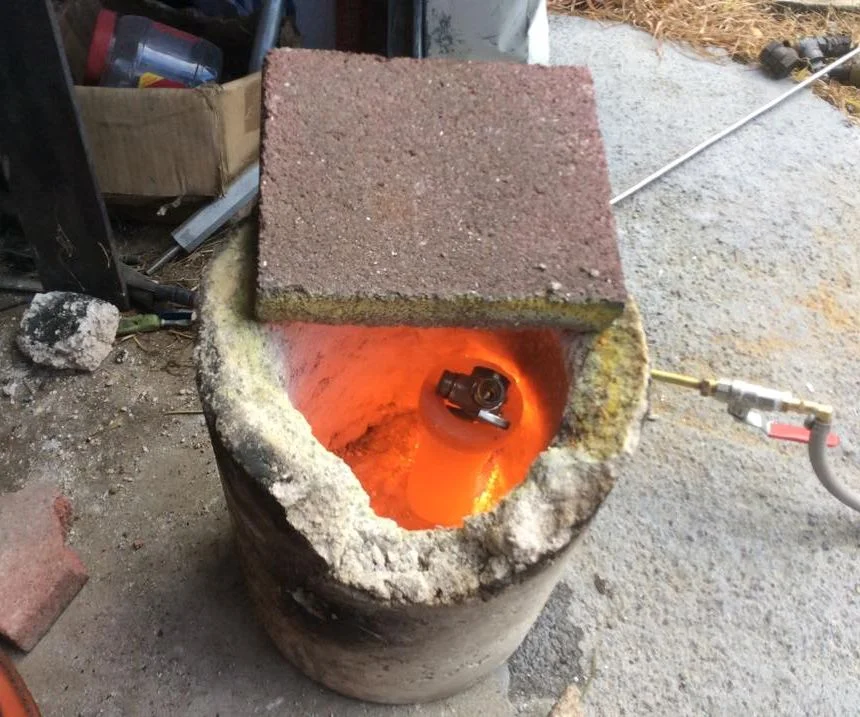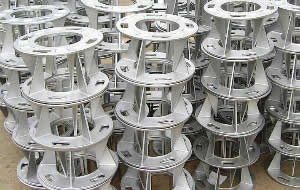The role of an Aluminum Casting Company in modern production processes
Discovering the Essential Applications and Use Aluminum Factory in Modern Manufacturing
Light weight aluminum shops play a necessary function in modern manufacturing, offering varied sectors with their distinct buildings. From automobile components that enhance fuel performance to aerospace structures that prioritize weight, light weight aluminum's flexibility appears. Its applications encompass building and customer electronic devices, highlighting its durability and energy efficiency. The innovations in light weight aluminum casting strategies and future patterns require a closer assessment, as they might redefine its effect on production.
The Role of Aluminum Foundries in Automotive Manufacturing
As the automotive sector increasingly prioritizes light-weight materials to boost gas efficiency and efficiency, light weight aluminum foundries have become necessary factors to producing processes. These shops focus on creating components that satisfy the strict demands of modern-day automobiles, such as engine blocks, transmission housings, and architectural aspects. Aluminum's favorable homes-- such as high strength-to-weight ratio, deterioration resistance, and exceptional thermal conductivity-- make it a perfect selection for vehicle applications.
Furthermore, aluminum shops utilize innovative casting strategies, including die spreading and sand casting, to create complex and resilient parts. This capacity permits makers to maximize styles for performance while decreasing weight. Making use of aluminum additionally supports sustainability objectives, as it is highly recyclable and minimizes power consumption in automobiles. By assisting in the assimilation of aluminum into auto design, factories play a crucial role in shaping the future of the vehicle sector, promoting effectiveness and advancement throughout the board.
Aerospace Applications: Lightweight Solutions for Flight
Aluminum foundries play a considerable duty in the aerospace sector, where the demand for lightweight materials is critical for improving gas performance and performance in aircraft. The unique residential properties of light weight aluminum, including its high strength-to-weight proportion and corrosion resistance, make it a perfect choice for different aerospace elements. These elements include structural parts, engine housings, and landing gear, which add to total airplane performance.
Making use of aluminum alloys, especially those created via innovative casting methods, enables for the production of elaborate designs and complex forms while minimizing weight. In addition, light weight aluminum's recyclability lines up with the aerospace market's sustainability goals, reducing ecological influence. With constant improvements in aluminum foundry technologies, suppliers can maximize manufacturing processes, leading to increased efficiency and lowered prices. As the aerospace market progressively prioritizes innovations that boost efficiency, aluminum shops will certainly continue to be important to establishing light-weight remedies for contemporary flight.
Structure and Building And Construction: Enhancing Architectural Honesty
In the building and construction sector, a considerable emphasis is positioned on improving structural honesty with making use of aluminum. Recognized for its high strength-to-weight ratio, aluminum gives durability without endangering on weight, which is essential in modern-day building styles. Its resistance to corrosion better guarantees long life, making it an optimal product for various architectural components, consisting of beam of lights, frames, and cladding.
Light weight aluminum likewise helps with innovative layout opportunities, allowing engineers and engineers to develop visually pleasing structures while preserving safety criteria. The material's versatility enables its application in both commercial and household tasks, from high-rise buildings to bridges. In addition, advancements in aluminum factory methods have actually boosted the accuracy of light weight aluminum components, ensuring they meet strict building ordinance. In general, the combination of aluminum in building not just improves architectural honesty yet additionally adds to lasting structure techniques, offered its recyclability and energy-efficient manufacturing methods.
Customer Electronic Devices: The Surge of Aluminum in Modern technology
In the domain name of customer electronic devices, aluminum has acquired prominence due to its lightweight layout benefits and premium thermal conductivity. This change not only improves product portability yet additionally boosts tool efficiency by successfully dissipating warm. As innovation continues to develop, the role of aluminum in developing smooth and effective gadgets is significantly substantial.
Light-weight Style Advantages
As consumer electronic devices advance, the need for light-weight yet long lasting products has surged, making aluminum a progressively prominent option amongst makers. Its low thickness permits the production of streamlined tools that are simple to carry and make use of, significantly improving portability. The strength-to-weight proportion of light weight aluminum assurances that items can withstand everyday wear and tear without endangering performance. Furthermore, the malleability of light weight aluminum allows manufacturers to make complex shapes and kinds, additionally contributing to cutting-edge visual appeals and functionality. This light-weight attribute likewise plays an important duty in power effectiveness, as lighter tools require less energy to operate. Therefore, light weight aluminum not just fulfills the progressing aesthetic demands but also lines up with the contemporary concentrate on sustainability in consumer electronics.
Thermal Conductivity Benefits
Thermal conductivity is an important variable in the efficiency of customer electronics, and aluminum excels in this domain name. Its high thermal conductivity enables for reliable warmth dissipation, which is crucial for maintaining ideal operating temperature levels in tools such as smartphones, laptops, and video gaming consoles. By promoting quick heat transfer away from delicate components, aluminum assists stop getting too hot, thereby enhancing performance and prolonging device longevity. The lightweight nature of aluminum matches its thermal homes, making it a suitable selection for mobile innovation. As makers progressively prioritize performance and power performance, light weight aluminum's function in thermal administration ends up being even a lot more significant, resulting in its growing fostering in modern-day digital designs. This trend emphasizes light weight aluminum's value in consumer electronic devices technology.
Marine Market: Corrosion Resistance in Harsh Environments
Deterioration Home Page resistance is an essential variable in the aquatic industry, where tools and frameworks are regularly exposed to harsh deep sea atmospheres. Aluminum, specifically in its alloy types, provides significant benefits hereof. Its natural oxide layer gives a safety barrier that protects against rust, making it perfect for vessels, anchors, and various other aquatic applications.
Marine-grade aluminum alloys, such as 5083 and 6061, are particularly developed to endure the harsh effects of deep sea and atmospheric problems. These alloys not only stand up to rust however additionally keep architectural integrity and stamina over time. Applications vary from hulls and superstructures of ships to elements in offshore systems.
The lightweight nature of light weight aluminum further enhances its viability, making it possible for enhanced fuel performance and simplicity of handling - aluminum foundry. As the marine industry remains to concentrate on resilience and performance, light weight aluminum stays an essential product selection for resisting deterioration in demanding aquatic settings
Developments in Light Weight Aluminum Spreading Techniques
While conventional aluminum spreading approaches have actually served the industry well, recent advancements are changing the landscape of light weight aluminum manufacturing. Techniques such as 3D printing of molds and cores are gaining traction, permitting fast prototyping and minimized preparations. This advancement enables producers to produce complicated geometries that were formerly tough to attain with standard spreading approaches. In addition, innovations in die-casting modern technology, consisting of making use of high-pressure die-casting (HPDC), have actually boosted the accuracy and surface area coating of actors aluminum elements, causing improved performance in different applications.
The fostering of investment casting has allowed for greater design freedom and reduced material waste. Advancements in alloy make-ups are also significant, as they enhance mechanical residential properties and rust resistance. In general, these this developments not just improve manufacturing procedures however likewise contribute to even more lasting techniques within the light weight aluminum factory sector, making it versatile to the developing demands of modern production
Future Patterns in Aluminum Foundry Manufacturing
The future of light weight aluminum factory manufacturing is positioned for significant improvement through automation, boosting efficiency and precision in making procedures. Sustainable methods are increasingly coming to be a priority, as shops seek to lessen their ecological impact while fulfilling growing regulative needs. Additionally, improvements in alloy growth will allow the production of stronger, lighter materials tailored for varied applications, driving innovation in the market.
Automation in Factory Processes

Sustainable Manufacturing Practices
An expanding focus on lasting production methods is improving the future of aluminum foundry manufacturing. Market leaders are significantly adopting energy-efficient innovations and reusing initiatives to lessen waste and minimize carbon footprints. The usage of recycled light weight aluminum considerably decreases energy consumption compared to main light weight aluminum manufacturing, making it a recommended option for ecologically conscious suppliers. On top of that, ingenious spreading methods are being established to boost material performance and minimize exhausts. Firms are likewise spending in renewable resource sources, such as solar and wind, to power their operations sustainably. aluminum foundry. By integrating these techniques, the aluminum foundry industry not only satisfies regulative demands yet also reacts to consumer demand for greener items, inevitably paving the method for a more lasting manufacturing landscape
Advanced Alloy Advancement
Developments in aluminum alloy advancement are set to play a significant role in the future of factory manufacturing, particularly as sustainability and performance demands intensify. The sector is increasingly concentrating on creating high-strength, light-weight alloys that can hold up against extreme conditions while minimizing environmental impact. Researchers are exploring innovative compositions, such as aluminum-lithium and aluminum-scandium alloys, which assure boosted mechanical residential properties and reduced weight. Furthermore, the combination of innovative production strategies, including additive manufacturing and precision casting, permits more facility geometries and decreased product waste. As regulatory stress and consumer choices shift towards greener options, the advancement of energy-efficient and recyclable alloys will certainly be necessary. The future landscape of light weight aluminum foundry production pivots on these innovations in alloy modern technology.

Frequently Asked Questions
What Are the Environmental Influences of Aluminum Shop Procedures?
Aluminum shop procedures can result in considerable ecological influences, consisting of greenhouse gas exhausts, energy consumption, and waste generation. In addition, inappropriate administration of contaminants might lead to soil and water contamination, influencing local ecological communities and communities.
Exactly How Does Light Weight Aluminum Recycling Affect Factory Processes?
Light weight aluminum reusing enhances foundry processes by supplying a cost-efficient basic material, reducing energy intake and discharges. This sustainable technique boosts efficiency, minimizes waste, and sustains the round economic situation, profiting both suppliers and the setting.
What Safety And Security Steps Are Applied in Light Weight Aluminum Foundries?
Light weight aluminum factories implement different precaution, consisting of personal protective equipment, proper ventilation systems, regular safety and security training, fire prevention methods, and devices maintenance procedures to decrease hazards and guarantee a secure working setting for all staff members.
How Do Foundries Guarantee Top Quality Control in Aluminum Casting?
Foundries ensure quality assurance in light weight aluminum spreading through extensive material assessments, accurate temperature level monitoring, standard treatments, and routine screening of actors products. These actions assist preserve consistency, minimize problems, and fulfill industry requirements effectively.
What Are the Price Consider Light Weight Aluminum Factory Manufacturing?
Cost elements in aluminum shop production consist of resources prices, energy usage, labor expenses, equipment maintenance, and overhead expenses. Furthermore, production quantity and complexity of styles significantly influence overall production costs and find more info earnings.
As the vehicle industry significantly focuses on lightweight materials to enhance fuel efficiency and performance, light weight aluminum foundries have actually ended up being important factors to producing procedures. Light weight aluminum factories play a significant function in the aerospace sector, where the demand for light-weight products is extremely important for improving fuel efficiency and performance in aircraft. In addition, developments in aluminum shop methods have actually enhanced the precision of aluminum components, ensuring they meet rigid structure codes. While typical aluminum casting approaches have served the sector well, recent advancements are changing the landscape of light weight aluminum production. The use of recycled light weight aluminum substantially lowers energy intake compared to primary light weight aluminum production, making it a recommended choice for environmentally conscious producers.